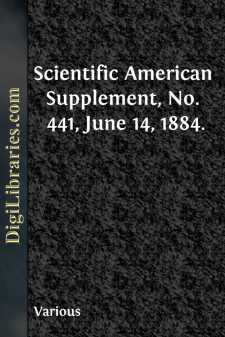Categories
- Antiques & Collectibles 13
- Architecture 36
- Art 48
- Bibles 22
- Biography & Autobiography 813
- Body, Mind & Spirit 142
- Business & Economics 28
- Children's Books 15
- Children's Fiction 12
- Computers 4
- Cooking 94
- Crafts & Hobbies 4
- Drama 346
- Education 46
- Family & Relationships 57
- Fiction 11828
- Games 19
- Gardening 17
- Health & Fitness 34
- History 1377
- House & Home 1
- Humor 147
- Juvenile Fiction 1873
- Juvenile Nonfiction 202
- Language Arts & Disciplines 88
- Law 16
- Literary Collections 686
- Literary Criticism 179
- Mathematics 13
- Medical 41
- Music 40
- Nature 179
- Non-Classifiable 1768
- Performing Arts 7
- Periodicals 1453
- Philosophy 64
- Photography 2
- Poetry 896
- Political Science 203
- Psychology 42
- Reference 154
- Religion 513
- Science 126
- Self-Help 84
- Social Science 81
- Sports & Recreation 34
- Study Aids 3
- Technology & Engineering 59
- Transportation 23
- Travel 463
- True Crime 29
Scientific American Supplement, No. 441, June 14, 1884.
by: Various
Categories:
Description:
Excerpt
FAURE'S MACHINE FOR DECORTICATING SUGAR-CANE.
The object of the apparatus shown in the accompanying engraving is to effect a separation of the tough epidermis of the sugar-cane from the internal spongy pith which is to be pressed. Its function consists in isolating and separating the cells from their cortex, and in putting them in direct contact with the rollers or cylinders of the mill. After their passage into the apparatus, which is naturally placed in a line with the endless chain that carries them to the mill, the canes arrive in less compact layers, pass through much narrower spaces, and finally undergo a more efficient pressure, which is shown by an abundant flow of juice. The first trials of the machine were made in 1879 at the Pointe Simon Works, at Martinique, with the small type that was shown at the Paris Exhibition of 1878. These experiments, which were applied to a work of 3,000 kilos of cane per hour, gave entire satisfaction, and decided the owners of three of the colonial works (Pointe Simon, Larcinty, and Marin) to adopt it for the season of 1880.
The apparatus is shown in longitudinal section in Fig. 1, and in plan in Fig. 2.
Fig. 3 gives a transverse section passing through the line 3-4, and Fig. 4 an external view on the side whence the decorticated canes make their exit from the apparatus.
FAURE'S MACHINE FOR DECORTICATING SUGAR CANE.
The other figures relate to details that will be referred to further along.
The Decorticating Cylinder.—The principal part of the apparatus is a hollow drum, A, of cast iron, 430 mm. in internal diameter by 1.41 m. in length, which is keyed at its two extremities to the shaft, a. Externally, this drum (which is represented apart in transverse section in Fig. 5) has the form of an octagonal prism with well dressed projections between which are fixed the eight plates, C, that constitute the decorticating cylinder. These plates, which are of tempered cast iron, and one of which is shown in transverse section in Fig. 7, when once in place form a cylindrical surface provided with 48 helicoidal, dentate channels. The length of these plates is 470 mm. There are three of them in the direction of the generatrices of the cylinder, and this makes a total of 24. All are strengthened by ribs (as shown in Fig. 8), and each is fixed by 4 bolts, c, 20mm. in diameter. The pitch of the helices of each tooth is very elongated, and reaches about 7.52 m. The depth of the toothing is 18 mm.
Frame and Endless Chain.—The cylinder thus constructed rotates with a velocity of 50 revolutions per minute over a cylindrical vessel, B', cast in a piece with the frame, B. This vessel is lined with two series of tempered cast iron plates, D and D', called exit and entrance plates, which rest thereon, through the intermedium of well dressed pedicels, and which are held in place by six 20-millimeter bolts. Their length is 708 mm. The entrance plates, D, are provided with 6 spiral channels, whose pitch is equal to that of the channels of the decorticating cylinder, C, and in the same direction. The depth of the toothing is 10 mm.
The exit plates, D', are provided with 7 spiral channels of the same pitch and direction as those of the preceding, but the depth of which increases from 2 to 10 mm. The axis of the decorticating cylinder does not coincide with that of the vessel, B', so that the free interval for the passage of the cane continues to diminish from the entrance to the exit.
The passage of the cane to the decorticator gives rise to a small quantity of juice, which flows through two orifices, b', into a sort of cast iron trough, G, suspended beneath the vessel. The cane, which is brought to the apparatus by an endless belt, empties in a conduit formed of an inclined bottom, E, of plate iron, and two cast iron sides provided with ribs. These sides rest upon the two ends of the vessel, B', and are cross-braced by two flat bars, e, to which is bolted the bottom, E. This conduit is prolonged beyond the decorticating cylinder by an inclined chute, F, the bottom of which is made of plate iron 7 mm. thick and the sides of the same material 9 mm. thick. The hollow frame, B, whose general form is like that of a saddle, carries the bearings, b, in which revolves the shaft, a. One of these bearings is represented in detail in Figs. 9 and 10....












